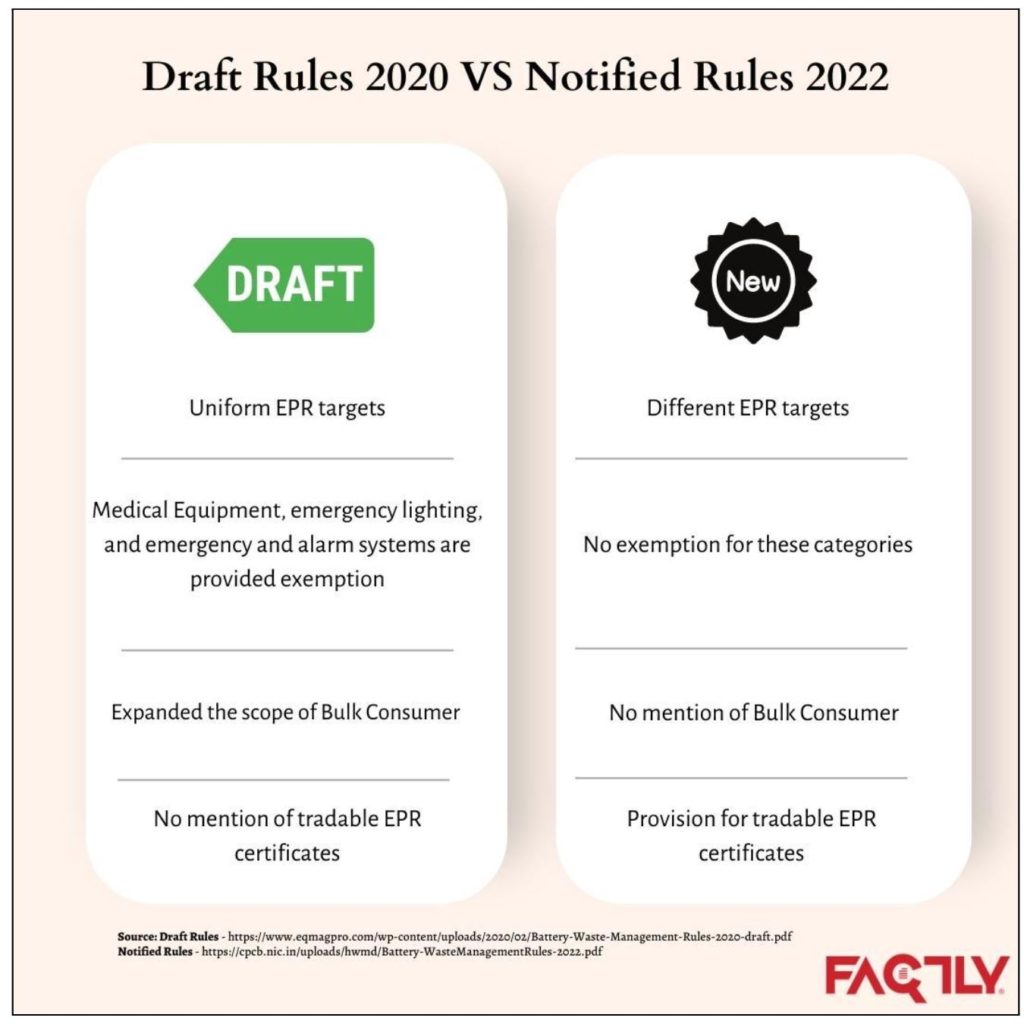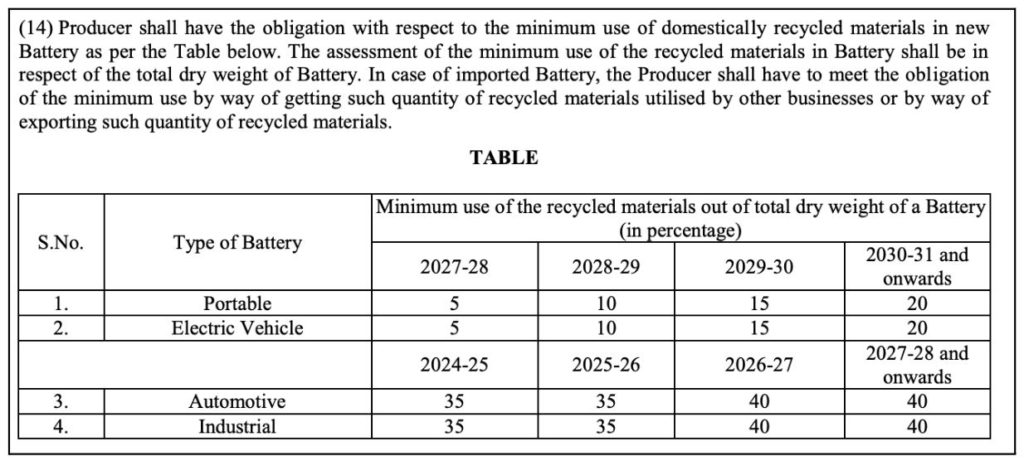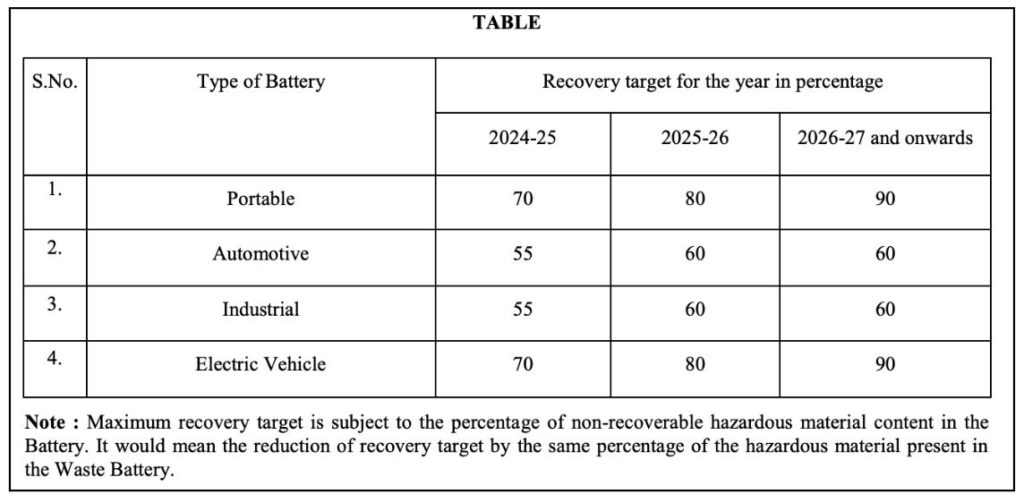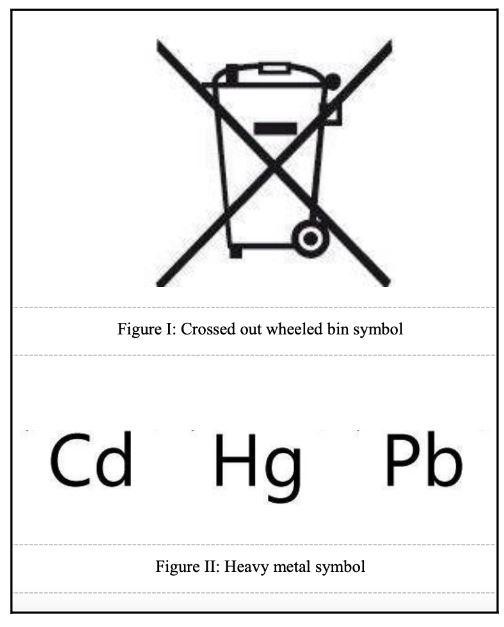The government recently notified the Battery Waste Management Rules, 2022 in the light of a greater push towards electric vehicles. The new rules are applicable to all types of batteries irrespective of their shape, volume, chemistry, usage, and material composition.
The excessive reliance and over-usage of fossil fuels have left severe consequences globally. Nations across the world are seriously contemplating plans to make the transition from non-renewable to renewable energy sources. India has also set ambitious targets to achieve 175 GW of renewable energy by the end of 2022 and expand it to 500 GW by 2030. In the transportation sector, the push towards renewable energy is mainly driven by Electric Vehicles (EVs). However, concerns remain over battery usage and its disposal, EV fire accidents, infrastructural challenges like the charging stations, and extraction of rare elements like Lithium, among other things.
A 2019 UN report estimated e-waste to be reaching 50 million tonnes in 2018 and is projected to reach 120 million tonnes by 2050. The annual value of global e-waste is estimated to be USD 62.5 billion. Less than a quarter of the e-waste is formally recycled, which is a cause of concern. It warned against the prevailing ‘take, make, and dispose’ model of the electronics industry and advocated for the reboot of this model in the form of the circular economy.
India is also one of the countries advocating for a faster transition towards EVs by extending subsidies and incentivizing the ecosystem. Demand for EVs is expected to grow manifold in the future because of which, the market for used EV batteries will grow in proportion to the increase in demand for lithium-ion batteries (LIBs), the best storage technology for EVs. A report by ICRIER estimated that by 2030, India would produce 14 lakh tonnes of LIB waste, a large portion of which will come from the EV industry. And more than 90% of the employment in this arena is unorganized and informal.
Considering these issues, the newly published Battery Waste Management Rules, 2022 assume greater significance. In today’s story, we look at the new rules and see how well they could be a game-changer for the future of EVs.
Genesis of Battery Waste management legislations
The earliest legislation regarding battery waste handling and management began in 2001, when the Ministry of Environment, Forests and Climate Change, Government of India, published The Batteries (Management and Handling) Rules, 2001. The rules provided for responsibilities for all the key players of the battery lifecycle – the manufacturer, assembler, importer, re-conditioner, consumer, bulk consumers, auctioneers, and the central pollution control board. These rules were amended in 2010, where the definition of a bulk consumer was changed from a consumer such as the Departments of Central Government like Railway Defence, Telecom, Posts and Telegraph, the Departments of State Government, the Undertakings, Boards and other agencies or companies who purchase batteries through central ‘rate’ or running contract centrally placed on behalf of individual departments or user units under their jurisdictions’ to “a consumer such as the Departments of Central Government like Railway Defence, Telecom, Posts and Telegraph, the Departments of State Government, the Undertakings, Boards and other agencies or companies who purchase hundred or more than hundred batteries per annum;” . Some other changes regarding the registration of importers were made in this amendment of 2010.
With times changing, it was felt necessary that these rules should be amended to comprehensively cover the changing landscape of Electric vehicles and advancements in battery technologies. Accordingly, the ministry published “Draft Battery Waste Management Rules, 2020” which was set to replace and supersede the Batteries (Management and Handling) Rules, 2001. The draft rules expanded the scope by including every possible kind of battery under its ambit, unlike the narrow scope of earlier legislation which defined a battery as a lead acid battery that is a source of electrical energy and contains lead metal. The draft 2020 rules also put the responsibility of ‘environmentally sound management of battery waste’ on the producers. It also added the dealer’s responsibility to raise an invoice in respect of every used battery received from the consumer. The 2001 rules fixed the responsibility of the dealer to give an appropriate discount to the consumer for every used battery returned. However, the latest draft rules do not contain any such provision.
The Battery Waste Management Rules, 2022
The recently notified Battery Waste Management Rules, 2022 are an updated form of the draft rules published in 2020, after considering the objectives and suggestions from all the stakeholders. These rules shall be applicable to all types of batteries irrespective of their shape, volume, chemistry, usage, and material composition. The only exemption from these rules is for the batteries used in essential security equipment including ammunitions, arms, war material and any other material intended specifically for military purposes, and for that equipment that is designed to be sent into space and its exploration. Some important features of these rules are the following.
- The latest rules lay emphasis on the circular economy and put obligations on the producers to use domestically recycled materials. This could push investments and deployment of the latest technologies used in waste extraction.
Clearly-defined recovery targets are set out for each industrial battery, and these targets shall be reviewed every four years by the committee constituted for the implementation of these rules.
Clear labelling requirements are specified if the battery contains heavy metals like mercury (Hg), Cadmium (Cd), and Lead (Pb). These element symbols must be printed below the symbol ‘crossed out wheeled bin symbol’ and shall cover an area of at least one-quarter the size of the crossed out wheeled bin symbol.
The targets for extended producer responsibility (EPR) are set depending on the kind of battery and the industry in which these batteries may be used. Accordingly, different targets are made out for Lead-acid, Li-Ion, Nickel Cadmium, Zinc based batteries, etc., and industries such as portable, automotive, industrial, and electric vehicle Batteries as mentioned in the Schedule II of the notified rules.
There are two ways of achieving the target fixed under the EPR. Either the producer shall bear the complete responsibility of the management of battery waste, or through the Extended Producer Responsibility certificate by purchasing surplus certificates from other producers of the same category of battery made available by recycler or refurbisher. These certificates are generated by the CPCB through centralized online portal based on the weight of battery processed, percentage fulfillment of material recovery targets for the specified year and geographical source of battery such as domestic or imported.
Non-fulfillment of EPR shall attract environmental compensation, which shall be levied by CPCB on the producer, and the respective state boards for entities involved in the battery lifecycle within their jurisdiction. This compensation is also levied for non-compliance to the rules regarding the registration, provision of false information, and submission of forged/manipulated documents, etc., It is important to note that payment of compensation does not absolve the responsibility on the producer.
The State Pollution Boards shall be responsible for the registration of entities involved in recycling and refurbishing. They must publish the list of entities not fulfilling EPR annually and shall also forward the quarterly compliance reports of these entities to CPCB.
It is the responsibility of the CPCB to establish a centralised online portal for registration and filing returns by recyclers, producers, and refurbishers of waste batteries within six months of the commencement of these rules. This portal shall act as a single-point data repository regarding the rules and implementation of battery lifecycle management in India.
A committee, headed by the chairperson of CPCB, shall be constituted to oversee the implementation of these rules and recommend the ministry accordingly. It is to be a broad and diverse committee with members from multiple backgrounds.
While these are some of the important features of the new rules, here are the changes made in the notified rules compared to the draft rules published in 2020.
Important modifications made from the draft rules 2020
- The draft rules of 2020 mention the Producer Responsibility Organization (PRO), which is an authorized entity managed by producer/(s) for the collection and channelization of battery waste. The notified rules 2022 does not explicitly mention PROs but provides for engaging or authorising any other entity for the collection and recycling of battery waste. However, the EPR targets shall remain with the producer only.
- The notified rules 2022 talk about exchangeable and tradable EPR certificates for fulfilling the EPR targets, whereas the draft rules 2020 did not contain any such provision. The notified rules, 2022 also talk about the schemes such as deposit refund system or buy back or any other model operated by producers to fulfill EPR obligations.

- The draft rules of 2020 contain provisions for developing a system of computerized tracking of the sale and distribution of batteries, the auction, collection, transport and re-processing of used batteries, and sale of lead from all producers or importers among other things. The notified rules, 2022 however, do not talk about this. Instead, it provides for the establishment of an online portal for the registration and submission of returns by recyclers, and refurbishers within six months of the implementation of these guidelines. The system also provides a mechanism for reflecting the material balance of Waste Batteries in accordance with the EPR obligations of Producers. It must also reflect information about the audit of Producers and organisations involved in the refurbishing and recycling of Waste Batteries.
- The draft rules 2020 provided for a fixed EPR target irrespective of the type of battery and its usage. However, the notified rules 2022 sets different targets for different types of batteries and the type of industry they are used in.
- While the notified rules 2022 make exemption from the application of these rules in war situations and equipment and space-related equipment, the draft rules 2020 included emergency and alarm systems, emergency lighting, and medical equipment in addition to the above two industries.
- The draft rules 2020 broadened the definition of ‘bulk consumer’ to include companies and health care facilities that have a turnover of more than one crore or have more than twenty employees in addition to the existing criteria. However, the notified rules 2022 are silent about the ‘bulk consumer’ category. In fact, it does not even make any mention of it.
A summary of important changes can below.

Featured Image: Battery Waste Management Rules, 2022






